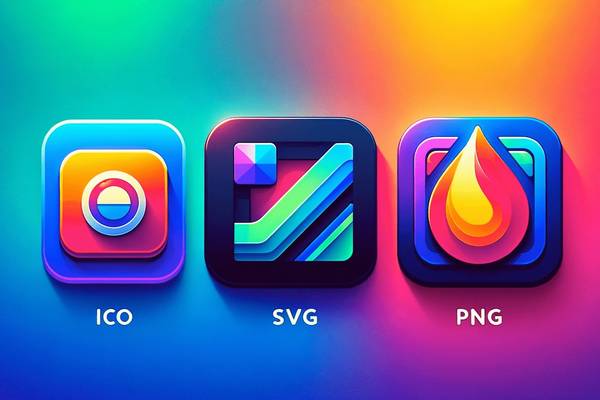Choosing the right image format for web elements: SVG, PNG or ICO?
Originally published: 28 December 2023
Coding is challenging but can be fun and rewarding

When designing web pages, one critical decision is selecting the appropriate image format for elements like small buttons and icons. The main contenders are SVG (Scalable Vector Graphics), PNG (Portable Network Graphics), and ICO (Icon) formats. Each has its strengths and ideal use cases.
SVG (Scalable Vector Graphics)
Scalability and Flexibility SVGs shine when it comes to scalability. Being vector-based, they maintain crisp quality at any size, which is crucial for responsive design. This makes them a perfect fit for elements that need to look sharp across various devices and screen resolutions.
Lightweight and Fast SVG files are often smaller than their PNG counterparts, especially for simpler graphics. This means quicker load times and better performance for your website.
Styling and Animation What sets SVG apart is its manipulability. You can style and animate SVGs using CSS and JavaScript, offering creative control to enhance user interaction.
Browser Support SVGs are widely supported across all modern browsers, making them a reliable choice for web development.
Styles May be inline, which may break CSP policies. You should be aware of this when choosing SVG as your preferred icon or image. They can be changed to use internal style sheets, especially with the help of AI!
Ideal Use Cases
- Icons and buttons on web pages.
- Graphics where scalability is key.
PNG (Portable Network Graphics)
High-Quality Images with Transparency PNGs support high-quality images and transparency, making them suitable for detailed graphics and images with gradients.
File Size Considerations While PNGs can be larger than SVGs for simple graphics, they can compress well for more complex images without losing quality.
Not Ideal for Scaling PNGs are raster-based, so they lose clarity when scaled up. This is a limitation if you’re designing for multiple screen sizes.
Ideal Use Cases
- Complex images where vector representation isn’t feasible.
- Detailed graphics that require raster format.
ICO (Icon)
Specialized for Favicons The ICO format is primarily used for favicons - the small icons displayed in browser tabs. It’s designed specifically for this purpose.
Multi-Size Capability An ICO file can contain multiple sizes of an icon, which can be useful for different display contexts.
Universal Browser Support All browsers support the ICO format for favicons, making it the go-to choice for this specific use.
Ideal Use Cases
- Favicons for websites.
Making the Right Choice
-
For Web Page Elements: SVG is generally the best choice for web elements like buttons and icons. Its scalability ensures your graphics look great on all devices, and the ability to style and animate with CSS and JavaScript is invaluable for interactive elements.
-
For Complex Graphics: PNG is a solid alternative for detailed images that require a raster format and are too complex for SVGs.
-
For Favicons: ICO remains the standard for website favicons due to its specialized use and compatibility.
In conclusion, while SVG is often the preferred format for web elements like buttons and icons, PNGs have their place in handling more complex images. ICOs are ideal for favicons, ensuring compatibility and functionality across browsers. Understanding the strengths of each format allows you to make the best choice for your web design needs, ensuring both aesthetic appeal and functionality.
Read Count: 0
 Facebook
Facebook
 Twitter
Twitter
 Email
Email